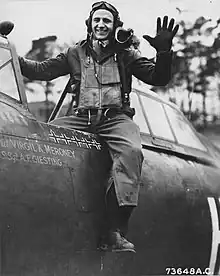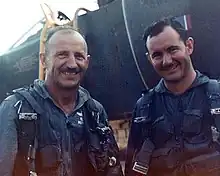Virgil K. Meroney | |
|---|---|
 Meroney in 1970 | |
| Born | February 16, 1921 Pine Bluff, Arkansas, U.S. |
| Died | June 27, 1980 (aged 59) |
| Buried | Graceland Cemetery, Pine Bluff |
| Allegiance | United States |
| Service/ | |
| Years of service | 1937–1970 |
| Rank | Colonel |
| Unit | |
| Commands held | |
| Battles/wars | |
| Awards | |
Virgil Kersh Meroney II (February 16, 1921 – June 27, 1980) was a United States Air Force colonel. During World War II, he became a flying ace credited with nine aerial victories while flying the P-47 Thunderbolt, making him the only P-47 ace in the 352nd Fighter Group. He himself was shot down and captured as a prisoner of war before his successful escape from captivity. He also flew missions during the Korean War and Vietnam War before he retired from the air force in 1970.
Early life
On February 16, 1921, Meroney was born in Pine Bluff, Arkansas.[1]
Military career
In May 1937, he joined the Arkansas National Guard and was called to active duty in May 1940. In 1941, he married Mildred Louise, née Duckett (1921–2009). The couple had two sons: Virgil III and Douglas.[1][2]
On March 27, 1942, he entered the flight training program of the United States Army Air Forces and earned his pilot wings. On October 30, 1942, he earned his commission as second lieutenant at Luke Field in Arizona.[3]
World War II

In December 1942, Meroney was sent to Westover Field in Massachusetts where he was assigned to the 487th Fighter Squadron within the 352nd Fighter Group and in January 1943, he completed training in the P-47 Thunderbolt. In June 1943, the 352nd FG landed in the United Kingdom, and was assigned to RAF Bodney in Watton, Norfolk. Flying P-47s in combat, Meroney downed his first German plane and shared another aerial victory with a fellow fighter pilot on December 1, 1943.[3][4]
Meroney scored his second aerial victory on December 4, 1943, along with a shared aerial victory. He shot down his fourth German plane on January 29, 1944, and on January 30, he shot down his fifth German plane, becoming the first flying ace in the 352nd Fighter Group.[3][4]
Meroney continued to raise his aerial victory score. On March 8, while escorting American bombers withdrawing after the bombing mission over Berlin, Meroney's flight engaged three Bf 109s led by German flying ace Klaus Mietusch that was attempting to attack the bombers. As Mietusch attacked the bombers from the rear, he managed to shoot down one of the B-17s but in return was shot down by Meroney, forcing Mietusch to bail out of his aircraft, and thus crediting Meroney with his eighth aerial victory. On March 16, he shot down his ninth German plane, which would be his last aerial victory of the war. In April 1944, the 352nd FG converted to the P-51 Mustang. On April 8, 1944, while strafing a German airfield, Meroney was shot down by anti-aircraft fire and he bailed out of his crippled P-51. He was captured by the Germans and was held as a prisoner of war until April 1945, when he escaped captivity and managed to reach American forces advancing towards the Rhine.[5][3]
During World War II, Meroney was credited in destroying nine enemy aircraft plus two shared and one damaged. For his aerial exploits during the war, he was awarded the Silver Star, five Distinguished Flying Crosses and four Air Medals. While serving with the 352nd FG, his P-47 was named after his wife, bearing the name "Sweet Louise".[6][3][4][1][7]
Cold War

Following his return to the U.S., from August 1945 to January 1946 Meroney was a flying instructor at Luke Field and continued to serve in the newly created United States Air Force. From 1950, he commanded the 561st Fighter Escort Squadron of the 12th Fighter Escort Group and led the unit to England from July to December 1951. He was later assigned to the 1211th Test Squadron in the Kwajalein Atoll from September to November 1952, where he took part in sampling missions in the aftermath of the Operation Ivy nuclear tests.[1][8][9]
From May to August 1953, he was assigned to Japan where he flew F-84 Thunderjets in combat during the last months of the Korean War. Meroney served in a variety of command and staff positions over the next 15 years. In 1968, during the Vietnam War, he was assigned to the 8th Tactical Fighter Wing at Ubon Royal Thai Air Force Base where he served as Deputy Commander for Operations and later as Vice Commander, and flew F-4 Phantom II in combat missions. He flew 141 combat missions and managed to fly at least two combat missions with his son Virgil III, before his son was killed in action on March 1, 1969, after his aircraft was shot down by anti-aircraft fire during a nighttime strike mission against enemy targets in Khammouan province, Laos.[1][3][10][11][12]
Meroney returned to the United States in February 1969 and was assigned to the Headquarters Tactical Air Command at Langley Air Force Base in Virginia, where he served as Assistant Chief of Safety and later as Chief of Safety before retiring from the air force on December 31, 1970.[1]
Later life
Meroney died of cancer on June 27, 1980, at the age of 59. He was buried at Graceland Cemetery in Pine Bluff.[13][3]
Aerial victory credits
| Date | # | Type | Aircraft flown | Unit assigned |
|---|---|---|---|---|
| December 1, 1943 | 1 | Bf 109 | P-47D | 487 FS, 352 FG |
| December 1, 1943 | 0.5 | Me 210/Bf 110 | P-47D | 487 FS, 352 FG |
| December 4, 1943 | 1 | Bf 109 | P-47D | 487 FS, 352 FG |
| December 4, 1943 | 0.5 | Fw 190 | P-47D | 487 FS, 352 FG |
| January 29, 1944 | 1 | Fw 190 | P-47D | 487 FS, 352 FG |
| January 30, 1944 | 1 | Bf 109 | P-47D | 487 FS, 352 FG |
| February 3, 1944 | 1 | Fw 190 | P-47D | 487 FS, 352 FG |
| March 8, 1944 | 1 | Bf 109 | P-47D | 487 FS, 352 FG |
| March 10, 1944 | 1 | Bf 109 | P-47D | 487 FS, 352 FG |
| March 16, 1944 | 1 | Bf 109 | P-47D | 487 FS, 352 FG |
- SOURCES: Air Force Historical Study 85: USAF Credits for the Destruction of Enemy Aircraft, World War II
Awards and decorations
 |
U.S. Air Force Command Pilot Badge |
 |
U.S. Air Force Parachutist Badge |
References
Notes
Citations
- 1 2 3 4 5 6 "Virgil K. Meroney". Veteran Tributes. Retrieved April 7, 2023.
- ↑ "Obituaries". Arkansas Democrat-Gazette. December 4, 2009. Retrieved April 8, 2023.
- 1 2 3 4 5 6 7 Michael O'Leary (2012). VIII Fighter Command at War 'Long Reach'. Bloomsbury Publishing Plc. p. 60. ISBN 9781782008927. Retrieved April 7, 2023.
- 1 2 3 Arthur Wylie (2009). Army Air Force Victories. Lulu.com. p. 231. ISBN 9780615155494. Retrieved April 7, 2023.
- ↑ Donald Nijboer (2022). The Mighty Eighth: Masters of the Air Over Europe 1942–45. Bloomsbury. p. 256. ISBN 9781472854247. Retrieved April 7, 2023.
- ↑ Martin W. Bowman (2009). Fighter Bases of WW II US 8th Army Air Force Fighter Command USAAF, 1943–45: P-38 Lightning, P-47 Thunderbolt and P-51 Mustang Squadrons in East Anglia, Cambridgeshire and Northamptonshire. Casemate Publishers. ISBN 9781783409167. Retrieved April 8, 2023.
- 1 2 3 4 "Virgil K. Meroney". Military Times. Retrieved April 7, 2023.
- ↑ Chapman, Kit (January 14, 2020). "Element Hunting in a Nuclear Storm". Distillations. Science History Institute. Retrieved April 7, 2023.
- ↑ Wolverton, Mark (2009). "Into the Mushroom Cloud Most pilots would head away from a thermonuclear explosion". Air & Space Magazine. Smithsonian (August). Retrieved April 7, 2023.
- ↑ "Meroney, Virgil Kersh III". Defense POW/MIA Accounting Agency. Retrieved April 7, 2023.
- ↑ Gaillard R. Peck, Jr (2019). Sherman Lead: Flying the F-4D Phantom II in Vietnam. Bloomsbury. p. 291. ISBN 9781472829382. Retrieved April 7, 2023.
- ↑ "Arkansas Magazine - Winter 2012". University of Arkansas. November 2, 2017. Retrieved April 7, 2023.
- 1 2 3 4 5 6 7 8 9 10 11 12 13 14 15 16 17 18 19 20 21 22 "Meroney, Virgil Kersh II". Together We Served. Retrieved April 7, 2023.
- ↑ "Prisoner of War Medal". Air Force Personnel Center. Retrieved April 10, 2023.
- ↑ "Republic of Korea Korean War Service Medal". Air Force Personnel Center. Retrieved April 10, 2023.